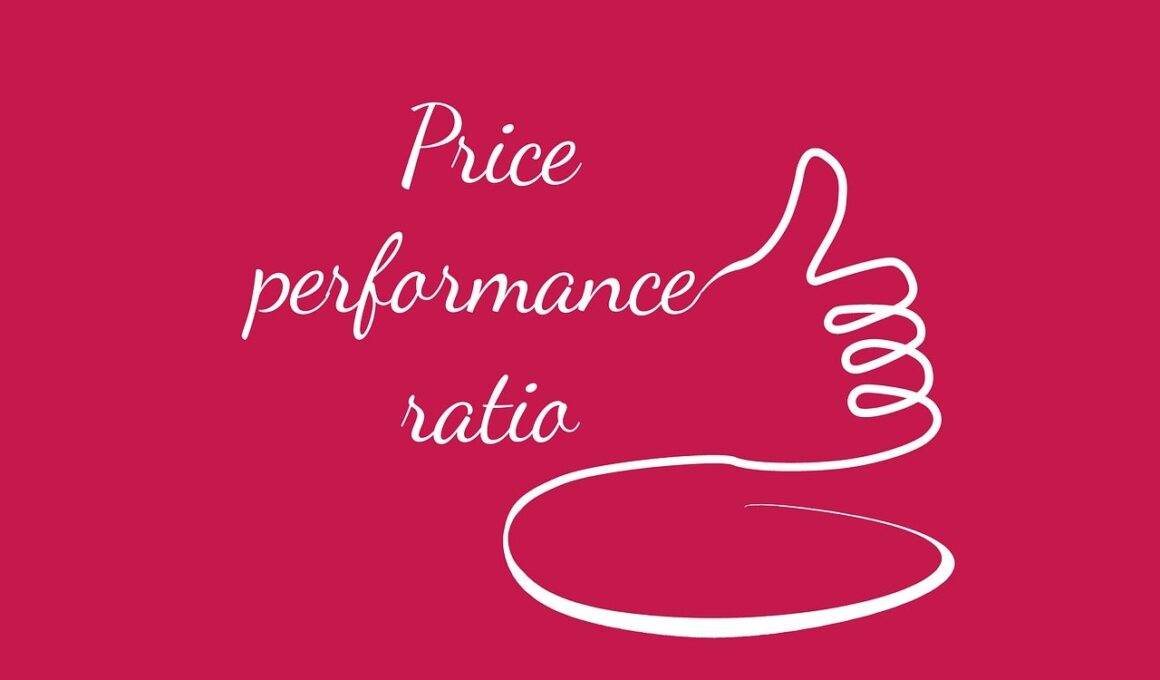Reducing Your Mutual Fund Costs: Tips to Lower Expense Ratios
Investors often overlook the significance of expense ratios when selecting mutual funds. Understanding this metric is crucial as it can significantly impact your overall returns. The expense ratio represents the percentage of a fund’s assets that go toward operating expenses, including management fees, administrative costs, and other associated expenses. Lower expense ratios can enhance your investment performance over time. High expense ratios can erode gains, especially in the long term, making it essential to consider them comprehensively. For instance, a fund with a 1% higher expense ratio could diminish returns by thousands of dollars over decades. Thus, focusing on expense ratios helps you keep more money invested. While evaluating mutual funds, compare the expense ratios of similar funds within the same category. Although some costs are unavoidable, mutual funds with lower expense ratios exist and can offer competitive returns. Actively managed funds typically have higher expenses than passively managed index funds, which generally capture market returns at a lower cost. It pays off to do your research consistently on this subject and prioritize funds that align with your financial goals and willingness to invest.
Investors should also consider mutual fund share classes, as they can influence expense ratios. Each share class has different fees and expense structures tailored for various investment strategies and time frames. For example, Class A shares might involve an up-front sales charge, while Class B and Class C shares typically have higher annual expenses instead of an upfront fee. Understanding these differences helps ensure you choose the option best suited to your financial goals and investment horizon. Research the fund company’s fee structure thoroughly; often, they offer different share classes associated with distinct fees. This understanding can significantly enhance your ability to reduce your expense ratios effectively. Moreover, mutual fund families often provide multiple funds targeting various investment goals. Leverage this to find other funds with lower fees that align with your investment philosophy while making sure your options are sustainable. Conduct ongoing analysis of your mutual funds’ performance and expenses to ensure they remain competitive. An annual fee review can yield tremendous savings over time. Tracking your expenses is key to effective portfolio management, allowing for better allocations based on your financial situation.
Evaluating Fund Performance vs. Expenses
While expense ratios are essential, they shouldn’t be considered in isolation. Evaluating fund performance relative to expenses is critical for investment decisions. A low expense ratio is only beneficial if it accompanies strong performance. Thus, ensure to consider a fund’s historical performance, risk-adjusted returns, and overall management quality when evaluating options. Funds that consistently outperform their benchmarks, despite higher fees, might still warrant consideration. Thoroughly analyze factors such as portfolio turnover and manager experience, as they can influence costs. Higher turnover can lead to increased transaction fees, impacting overall expenses and, subsequently, your returns. Invest in funds whose managers demonstrate a history of successful strategy execution. Also, consider using research tools and independent platforms providing comparative analyses of funds regarding performance and expenses. Keeping a diversified portfolio can assist in offsetting some of the costs associated with higher expense ratios. By mixing low-cost index funds with a few actively managed funds, complex interactions can balance overall expenses and potential returns. Ultimately, balancing cost and performance should be a fundamental component of your investment approach.
Consider the impact of market conditions on mutual fund expenses. Costs may increase during market volatility or economic downturns due to increased management activity attempting to navigate challenging environments. In these circumstances, funds may charge higher fees, and understanding how expense ratios adapt can help preserve returns in turbulent times. Investors should be vigilant and adaptive, reassessing their mutual funds’ expense structures regularly. Look for funds that have an established record of maintaining stable expense ratios during various market conditions. This stability can indicate competent management practices, enabling you to avoid hidden costs. Additionally, review whether the fund’s strategy remains aligned with your expectations and market realities. The performance trends and contextual changes significantly affect costs associated with funds. Always verify if reallocating your investments into lower-cost alternatives could enhance your overall returns, as markets continuously evolve. Regularly reassessing your portfolio is essential to maximize returns, particularly considering changing economic climates. Understanding how macroeconomic factors affect mutual funds can lead to better decision-making and fewer unexpected expenses.
Utilizing Technology for Efficient Tracking
Technology plays a pivotal role in managing mutual funds effectively. Utilizing platforms and applications designed for tracking expenses can streamline the assessment of your mutual funds’ performance against their expense ratios. Financial technology enables investors to analyze funds, review historical expenses, and even set alerts for significant changes in fee structures. Using investment apps helps you create a customized expense reporting system tailored to your portfolio’s needs. These resources can provide timely updates regarding expense ratio changes and alert you to funds becoming less attractive due to rising costs. Furthermore, some tools can aid in tax-loss harvesting, reducing the effect of expenses on overall returns. By remaining proactive with technology, you can increase your engagement level with your investments, ensuring they continually align with your long-term financial objectives. Detailed tracking allows for timely adjustments, optimizing performance and reducing unnecessary costs. Since the financial landscape is continually evolving, being equipped with the right technology ensures that your mutual fund choices remain sound in the face of changing conditions. Finally, adopting technology reduces information overload, promoting simpler and more accessible analysis.
Another way to lower expense ratios is by investing through low-cost brokerage platforms. Many of these brokerages offer commission-free trading and lower fees than traditional investment firms. Thus, actively participating in optimizing your cost structure becomes more manageable. Choose platforms that have a reputation for transparent pricing and innovative solutions with less friction for fund purchases. By leveraging these lower-cost brokerage solutions, it becomes easier to invest in lower-expense mutual funds. Look for brokerages providing no-load funds to avoid sales charges. Comprehensive research should guide your selection process in brokerages, weighing the trade-offs between costs and service quality. Emphasizing this aspect can lead to considerable savings in expense ratios across your portfolio. When evaluating brokerages, take note of the educational resources they provide, facilitating your understanding of managing expenses efficiently. Many platforms also offer user-friendly interfaces to track fund performance relative to expenses. Remember that choosing the right broker plays a considerable role in keeping overall costs low. Ultimately, staying informed on options helps maintain your portfolio’s health, promoting sustainable financial growth.
Final Thoughts on Expense Ratios
Navigating the complex world of mutual funds requires a strategic focus on expense ratios to optimize investment performance. By staying informed and proactive, investors can implement strategies to reduce costs effectively. This includes understanding the nuances of share classes, fund expenses, and technological aids while considering market conditions. Keeping these factors in mind helps ensure that you select funds that align with your goals without incurring unnecessary fees. Monitoring expense ratios and performance regularly is crucial to avoid slipping into costly territory over time. Also, diversifying investments while balancing low-cost index funds with carefully selected active funds may yield optimal results. Each investor’s situation is unique, so customizing your approach based on individual preferences and needs will maximize outcomes. As you consider your ongoing investment strategy, remember that incorporating strategic expense reduction leads to more significant wealth accumulation over time. Stay engaged in your investments, continually reassess their performance and costs, and remain adaptable to evolving markets. Lowering expense ratios is not a one-time task, but an ongoing endeavor essential for long-term investment success.
Ultimately, successfully reducing your mutual fund costs requires diligence and proactive management. Embrace the habit of regularly reviewing your investments, asking questions about fees, and exploring opportunities to enhance performance. By maintaining a comprehensive understanding of expense ratios, you’ll be better equipped to make informed decisions that positively influence your portfolio. The empowerment gained from understanding these concepts not only aids in better management but also fosters confidence in investment choices. Educating yourself about mutual funds, their expenses, and navigating brokerage platforms can substantially affect your investment journey. Every dollar saved on expenses contributes directly to your overall returns, emphasizing the importance of staying vigilant. Engage with resources and tools available to you, enhancing your understanding of investment landscapes and expense management. Gradually, your approach will evolve, enabling you to implement strategies that prioritize lower costs and promote growth. The foundation for a successful investment experience rests upon this commitment to understanding and managing expenses. With diligent efforts in maximizing your investments, you’ll enhance the likelihood of achieving your financial goals and aspirations.


